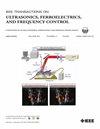利用机器人配准复合和非刚性变形校正提高经颅大鼠脑三维超分辨率成像视场。
IF 3.7
2区 工程技术
Q1 ACOUSTICS
IEEE transactions on ultrasonics, ferroelectrics, and frequency control
Pub Date : 2025-03-29
DOI:10.1109/TUFFC.2025.3574916
引用次数: 0
摘要
随着能够进行体积成像的二维探针的应用,超声大视场脑成像越来越容易实现。然而,即使在小动物中,颅骨也存在明显的屏障,传统的平面波经颅成像在某些区域缺乏成像能力,导致不完整的超分辨率血管重建。本文采用高精度6自由度机器人方法来优化经颅传输路径,并生成复合复合体,从而提高视野和成像填充率。3D经颅模拟量化了颅骨对US传播的影响,并与体内大鼠脑结果一起验证,用于确定经颅成像±12°的最佳角度换能器方向。通过将这些角度与高度平移相结合,完成了具有改进视野的大鼠脑成像。利用机械臂的几何定位数据,结合非刚性变形校正,将9个方向的3D超分辨率结果组合在一起,以解释颅骨畸变差异。所得到的复合结果与Waxholm空间大鼠脑图谱相对照,背景化微血管。与单独的零角度方向相比,复合结果显示,所有被检查的大脑区域的血管相关体素数量至少提高了350%。采用新颖的三维自适应滚动傅立叶环相关方法进行局部分辨率测量,在10 ~ 85 μm的取向超分辨率结果之间显示出一致的分辨率测量结果。本文章由计算机程序翻译,如有差异,请以英文原文为准。
Improving Imaging Field of View of 3-D Transcranial Rat Brain Super-Resolution With Robotic Registered Compounding and Nonrigid Deformation Correction
Large field-of-view (FOV) brain imaging with ultrasound has become increasingly achievable with the application of 2-D probes capable of volumetric imaging. However, even in small animals the skull presents a significant barrier and conventional plane-wave transcranial imaging lacks the capability to image in some regions, resulting in incomplete super-resolved vascular reconstructions. Here a high-precision 6 degree-of-freedom robotic approach is used to optimize the transcranial transmission path and to generate composite compounded volumes that improve the field of view and imaging fill fraction. Three-dimensional transcranial simulation quantifies the effect that the skull has on US transmission, and, together with in vivo rat brain results for validation, was used to determine optimal angled transducer orientations for transcranial imaging of ±12°, laterally. Rat brain imaging with an improved FOV was accomplished by a combination of these angles with elevational translations. The 3-D super-resolution results of nine orientations were compounded together using geometric positioning data from the robot arm in combination with a nonrigid deformation correction to account for skull aberration differences. The resulting compounded result was registered against the Waxholm Space rat brain atlas, contextualizing the microvessels. As compared to the zero-angle orientation alone, the compounded result showed improvements in number of vessel-associated voxels for all examined brain regions by at least 350%. Local resolution measurements by a novel 3-D adaptation of a rolling Fourier ring correlation (FRC) approach was used to show consistent resolution measurements between orientation super-resolution results between 10 and $85~\mu $ m.
求助全文
通过发布文献求助,成功后即可免费获取论文全文。
去求助
来源期刊
CiteScore
7.70
自引率
16.70%
发文量
583
审稿时长
4.5 months
期刊介绍:
IEEE Transactions on Ultrasonics, Ferroelectrics and Frequency Control includes the theory, technology, materials, and applications relating to: (1) the generation, transmission, and detection of ultrasonic waves and related phenomena; (2) medical ultrasound, including hyperthermia, bioeffects, tissue characterization and imaging; (3) ferroelectric, piezoelectric, and piezomagnetic materials, including crystals, polycrystalline solids, films, polymers, and composites; (4) frequency control, timing and time distribution, including crystal oscillators and other means of classical frequency control, and atomic, molecular and laser frequency control standards. Areas of interest range from fundamental studies to the design and/or applications of devices and systems.

 求助内容:
求助内容: 应助结果提醒方式:
应助结果提醒方式:


